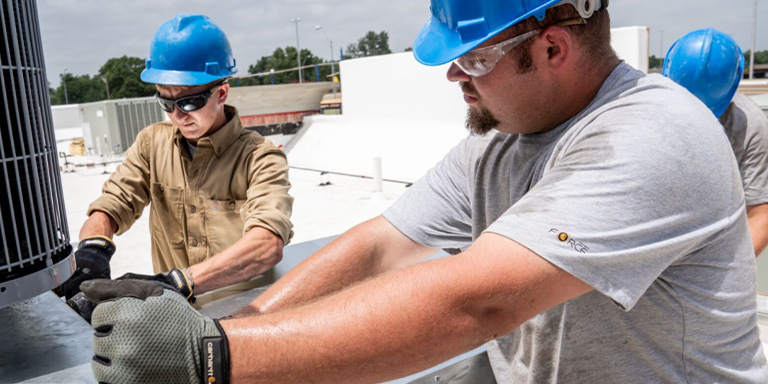
As infrastructure, industry and everyday life become more and more technical, the demand for skilled tradespeople is on the rise. Contrary to what some may think, there are many reasons to learn a blue-collar trade. But how do you become a trade apprentice or get into vocational school? There are many different paths to take, so we'll outline everything that you need to know about applying for an apprenticeship.
What is a Trade Apprenticeship?

These types of training programs are designed to give people all the skills, knowledge and hands-on experience they need to become full-fledged trade professionals. Some trades may or may not require schooling, but licensing or certification is usually required either to work legally or show professional qualifications.
Once accepted into a program, apprentices typically work under a journeyperson (someone who's already completed their apprenticeship) to learn the trade. The amount of time it takes to complete an apprenticeship varies by industry and can be anywhere from 1-6 years. There are many types of professional trades, but they can be classified into these groups:
- Mechanical trades include: automotive technicians, HVAC installers and machinists
- Construction trades include: tile setters, electricians and plumbers
- Industrial trades include: metal fabricators, ironworkers and steam engineers
- Culinary trades include: chefs, bakers and brewers
- Medical trades include: dental hygienists, nurses and phlebotomists
Find Programs that Suit Your Skills and Interests

One of the greatest appeals of apprenticeships is that they allow you to earn while you learn. You likely won't be saddled with student debt when you complete the program, either. If you do choose a trade that requires schooling, remember that job placement is typically provided, and you will earn enough to offset any loan payments. When doing your research, it's a great idea to take plenty of notes.
Some questions to ask yourself are:
- Do you want a union or non-union job?
- What kind of work environment do you prefer: outdoors or indoors?
- Do you plan on transferring to college?
- Do you want a job that involves math skills?
- Would you prefer more hands-on or technical work?
- Do you want to attend school or receive direct instruction from a journeyperson?
Consider your talents, hobbies and background when deciding on a trade. If you're unsure what trade would suit you best, it might be a good idea to take a job placement test either online or through a career center. You might also be able to find a pre-apprenticeship program to get you prepared.
Before you make up your mind about an apprenticeship, find and interview tradespeople who have experience in the field. Be sure to ask them what a day at work is like. It may also be a good idea to ask whether they think you would be a good fit in that position. Interviewing a tradesperson is a good idea whether or not you've decided on an apprenticeship or other vocational program.
It's also incredibly important to understand job growth and the average salary of different trades when doing your research. Since automation and technological advancements will kill many jobs in the coming years, be sure you understand the prospects of the trade you're looking into. For example, if you want to become an automotive technician, be prepared for the coming electric vehicle revolution by understanding that you will need special knowledge and training to remain relevant.
You can also talk to a career counselor at a job agency or an admissions counselor at vocational schools you're looking at. Whichever trade you choose to pursue, just remember that having transferable technical skills is invaluable in today's job market.
Be Aware of Requirements

Most apprentices must be 18 years or older, but be sure to double check since some programs might have their own requirements. Also, the nature of trade work involves being on your feet and working with your hands all day, so remember that most of these jobs are physically demanding in one way or another. For example, if you want to lift stuff and get dirty, then a career as a dental hygienist might not be the best pick for you.
Be aware of educational requirements, if there are any. Most apprenticeships require a high school diploma or GED, and vocational schools may look at your high school test scores to decide if you'd be a good fit. If you're hoping to go into a highly technical field but lack the test scores to show an aptitude for math, this may hinder your ability to get in. Remember, though, that showing an enthusiasm to learn goes a long way, and that using math on the job can be much more satisfying than doing it in a classroom.
Be sure to check if there are any licenses or certificates needed to break into your chosen apprenticeship. The Automotive Service Excellence (ASE) organization, for example, offers an entry-level certification for people who want to show their dedication and trainability. Getting a job at an auto shop definitely requires a driver's license, but this is also required for many other trades. Regardless, having a valid driver's license shows a level of responsibility that will boost your professional image.
Make Sure The Program Is Legit
While most schools and programs will obviously be legitimate, it's important to remember that there are scammers out there who set up fake apprenticeships for various reasons. Making sure an apprenticeship is real can be especially important if your prospect is an independent contractor or small business. Remember that all trade apprenticeships must:
- Be at least 30 hours per week
- Pay at least the apprenticeship minimum wage
- Have an apprenticeship agreement
- Provide appropriate technical knowledge
- Provide relevant work experience
If you are in doubt about the legitimacy of a program, do some online research to find out more. Just search the company's name and check the Better Business Bureau for anything shady. Whether or not you think the program is legit, be sure to look for websites with employee reviews so you can know what you're getting yourself into. Also be sure that the timeframe and curriculum is similar for other programs.
Craft an Excellent Resume and Cover Letter

Applying for an apprenticeship is usually like applying for a job. Remember that these training programs are in high demand since trade jobs are growing, and companies will only want to pay apprentices who are worth their time and effort. For some people, applying for an apprenticeship may be the only job they ever have to hunt for. That's why it's so important to know how to do it right.
Be sure to gather references and a recommendation letter or two. These letters can come from a school counselor, a coach, a teacher, or they can come from an employer or someone who you volunteered for. Be sure to get at least three good references together; these should be professional contacts (but if you have none, friends and family may be ok).
Crafting a Resume
Here's what to remember when writing your resume:
- The format must be simple and efficient. Yours will likely be one of many applications, so make it catchy, professional and sleek.
- Contact information must include your phone number and email address at the top of the page below your name.
- Relevant experience is the bulk of the information on a resume. If you don't have any work experience, then be honest and write that. The point is to show relevant experience, not just work experience. What things in your life make you a good fit for the program that you're applying for? This can include volunteer experience.
- Make it about past experience to show your experience and background. You will showcase your skills in your cover letter.
Crafting a Cover Letter
Here's what to remember when writing a cover letter:
- Research the company: It's a good idea to do some research into the company you're applying to before drafting your cover letter. Look on their website and take lots of notes about their history, culture and leadership, as well as the job description. Sneak exact phrases from their site into your letter to show that you did your research and know what to contribute.
- Open strong: You'll want to catch the hiring manager's attention and immediately show them that you're the best candidate for the apprenticeship. Make your cover letter stand out from the stack by showing (not telling) the hiring manager that they should hire you in the first sentence. You can refer to something on the company's website or refer to transferable skills and experience, but remember to avoid humor and stay professional. If you have a reference that works for the company, put their name in the first sentence.
- Make your cover letter about the future: Explain why you're shifting into a trade apprenticeship. Are you a recent graduate or soon to be one? Maybe you just want to learn something new, useful and lucrative? Whatever the reason, keep it brief and professional. Aim for well under a page, and remember that yours is one of hundreds the hiring manager may read.
- Maintain a professional tone and voice: You want to convey professionalism and maturity in your cover letter, so focus on not sounding desperate or only slightly interested. Each cover letter you send should be unique to the company; do not copy and paste the same letter. Show the hiring manager that you took the time to write them a letter because you're enthusiastic about working with them specifically.
- Show your value: Do you currently possess any skills that can be transferred to the apprenticeship that you're applying for? Do you have any special talents that might be useful? Make sure you convey enthusiasm, especially in the first sentence. Let the hiring manager know this apprenticeship is the path to your dream job, and that you're already dedicated to becoming a tradesperson. This will help to show your personality and increase your chances of getting the apprenticeship.
- Show problem-solving skills: Show the company that you're useful to them specifically. Refer to specific things on their website, and feel free to use some of the exact wording. This will show that you have problem-solving and research skills as well as a dedication to their business. If you have any industry certifications or licenses (or if you have the desire to attain them), include that as well.
-
Get feedback: Do not send your letter right after you've written it, but don't spend too much time on revision either. Always reread it, wait and then reread it again while keeping an eye out for mistakes. Find a few people to read it and give you feedback. Seek critical feedback like:
- Are there places that can be cut?
- Is the letter overselling your skills and talents?
- Is it underselling your skills and talents?
How To Apply To A Trade School

Not all trades are learned through apprenticeship programs, but all of them do require on-the-job training to become qualified. If you get accepted into an apprenticeship program that requires school on top training with a journeyman, be sure to talk with them before deciding on a program. Remember that you will need a high school diploma or GED to apply for vocational programs, so make sure you have this squared away before anything else.
There are three types of institutions that offer vocational training:
- Trade schools
- Community colleges
- Four-year colleges
Before applying or deciding on the trade you want to pursue, make sure you understand the costs of tuition and the student loan process (if you're using it). Also check that the school has exactly the right program you want. For example, people who are looking to become automotive technicians would be wise to find a program that includes a focus on electric vehicles. It's also crucial to make sure that the academic schedule works with you, your employer and your family.
The process of getting started with an admissions application is straightforward and easy. Remember that you can always contact one of the school's admissions representatives to answer any of your questions and help you complete the process. After you've done plenty of research and made a decision, simply visit the school's website and fill out the admissions application (and also the FAFSA application if you are getting federal student loans). If you are getting private loans, apply for these as well.
Deciding to learn the skills of a trade takes a significant investment of time and energy, so you should do plenty of research before making any commitments to a vocational training program. Despite all the hard work, the benefits of completing an apprenticeship program include a rewarding income, job security and a daily sense of accomplishment.
Did you find this article helpful?



